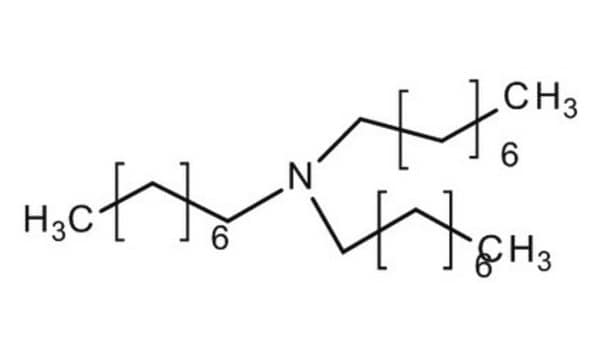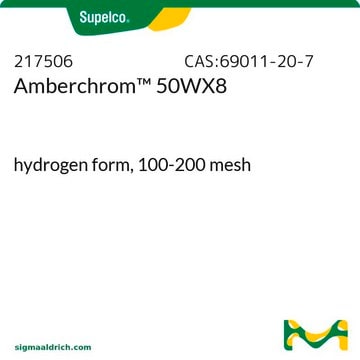471313
Tributylamine
≥98.5%
Sinonimo/i:
Tri-n-butylamine
About This Item
Prodotti consigliati
Densità del vapore
6.38 (vs air)
Livello qualitativo
Tensione di vapore
0.3 mmHg ( 20 °C)
2.4 mmHg ( 55 °C)
Saggio
≥98.5%
Forma fisica
liquid
Temp. autoaccensione
410 °F
Limite di esplosione
6 %
Indice di rifrazione
n20/D 1.428 (lit.)
pH
10.2 (25 °C, 0.1 g/L)
P. eboll.
216 °C (lit.)
Punto di fusione
−70 °C (lit.)
Densità
0.778 g/mL at 25 °C (lit.)
Stringa SMILE
CCCCN(CCCC)CCCC
InChI
1S/C12H27N/c1-4-7-10-13(11-8-5-2)12-9-6-3/h4-12H2,1-3H3
IMFACGCPASFAPR-UHFFFAOYSA-N
Cerchi prodotti simili? Visita Guida al confronto tra prodotti
Descrizione generale
Applicazioni
- An extraction solvent with CHCA (α-cyano-4-hydroxycinnamic acid) for the selective phospholipids (PLs) extraction from EVOO (extra virgin olive oil) and HO (hazelnut oil).
- A hydroxylating agent in the synthesis of spinel nickel ferrites (NiFe2O4) nanoparticles (NPs).
Caratteristiche e vantaggi
Avvertenze
Danger
Indicazioni di pericolo
Consigli di prudenza
Classi di pericolo
Acute Tox. 1 Inhalation - Acute Tox. 2 Dermal - Acute Tox. 4 Oral - Skin Irrit. 2
Codice della classe di stoccaggio
6.1A - Combustible acute toxic Cat. 1 and 2 / very toxic hazardous materials
Classe di pericolosità dell'acqua (WGK)
WGK 1
Punto d’infiammabilità (°F)
145.4 °F - closed cup
Punto d’infiammabilità (°C)
63 °C - closed cup
Certificati d'analisi (COA)
Cerca il Certificati d'analisi (COA) digitando il numero di lotto/batch corrispondente. I numeri di lotto o di batch sono stampati sull'etichetta dei prodotti dopo la parola ‘Lotto’ o ‘Batch’.
Possiedi già questo prodotto?
I documenti relativi ai prodotti acquistati recentemente sono disponibili nell’Archivio dei documenti.
I clienti hanno visto anche
Il team dei nostri ricercatori vanta grande esperienza in tutte le aree della ricerca quali Life Science, scienza dei materiali, sintesi chimica, cromatografia, discipline analitiche, ecc..
Contatta l'Assistenza Tecnica.













